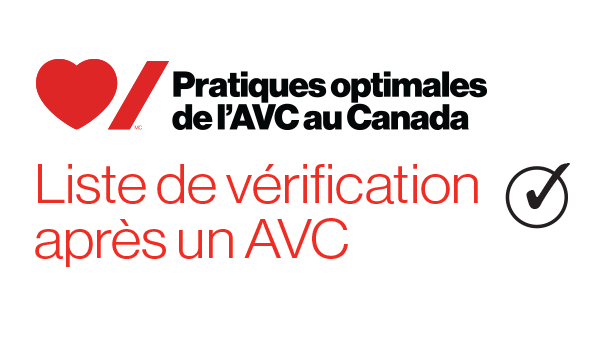- Définition et considérations
- 1. Évaluation initiale des besoins en matière de réadaptation post-AVC
- 2. Soins offerts dans les unités de réadaptation post-AVC
- 3. Prestation des soins de réadaptation post-AVC en milieu hospitalier
- 4. Réadaptation à domicile et en consultation externe post-AVC (y compris le congé précoce assisté)
- 5.1 Prise en charge des membres supérieurs après un AVC : principes généraux et traitements
- 5.2 Amplitude du mouvement et spasticité de l’épaule, du bras et de la main
- 5.3 Prise en charge de la douleur à l’épaule et du syndrome douloureux régional complexe (SDRC) après un AVC
- 6.1 Équilibre et mobilité
- 6.2 Spasticité des membres inférieurs après un AVC
- 6.3 Prévention et prise en charge des chutes
- 7. Évaluation et prise en charge de la dysphagie et de la malnutrition après un AVC
- 8. Réadaptation en cas de troubles de la perception visuelle
- 9. Prise en charge de la douleur centralisée
- 10. Réadaptation en vue d’améliorer la capacité à parler et à communiquer
- 11. Téléréadaptation après un AVC
3. Prestation des soins de réadaptation post-AVC en milieu hospitalier
6ème édition - 2019 MISE À JOUR
Recommandations
- Une fois dans un état stable, les patients ayant subi un AVC devraient tous recevoir des soins de réadaptation actifs dès qu’ils y sont aptes [niveau de preuve A]. Pour de plus amples renseignements, se reporter à la section 1, dans l’ encadré 1 : Critères d’admissibilité et d’admission à la réadaptation post-AVC.
- Il n’est pas recommandé de mobiliser de façon précoce et prolongée les patients au cours des premiers jours suivant un AVC, surtout lorsque ce dernier était grave [niveau de preuve A].
- La mobilisation précoce est envisageable pour certains patients atteints d’un AVC en phase aiguë, comme un AVC léger ou un AIT, mais la prudence et le jugement clinique sont de mise [niveau de preuve C].
- Une fois jugés stables sur les plans médical et neurologique, les patients ayant subi un AVC devraient suivre des traitements directs axés sur une tâche particulière au moins trois heures par jour, cinq jours par semaine, sous la direction de l’équipe interprofessionnelle de soins de l’AVC [niveau de preuve C]. Plus l’intensité du traitement est forte, plus les résultats s’améliorent [niveau de preuve A].
- Les plans de réadaptation personnalisés doivent être axés sur le patient, adaptés aux réalités culturelles de ce dernier, et tenir compte des préférences et des objectifs du patient, de sa famille, de ses aidants ainsi que de l’équipe de soins élaborés dans le cadre d’une prise de décision partagée [niveau de preuve C].
- L’optimisation des soins de réadaptation que reçoivent les patients nécessite l’adaptation de leur intensité et de leur durée en fonction de leurs besoins et de leur tolérance [niveau de preuve A].
- Le traitement devrait comprendre la pratique intensive et répétitive de tâches valorisées par le patient qui le mettent au défi d’acquérir les habiletés nécessaires en vue d’accomplir des tâches et des activités fonctionnelles [niveau de preuve A].
- L’équipe devrait promouvoir la mise en application des compétences acquises pendant le traitement dans la routine du patient durant son séjour à l’hôpital [niveau de preuve A] et après sa sortie dans la communauté [niveau de preuve C].
- Une évaluation des besoins devrait être effectuée avant la transition (sortie vers un autre milieu) pour que le retour à la collectivité se déroule en douceur [niveau de preuve B].
- La planification de la transition devrait inclure les points suivants:
- Une visite à domicile d’un professionnel de la santé, idéalement avant la sortie, lorsque l’équipe de réadaptation ou la famille craignent que des changements dans les capacités de communication ou de nature fonctionnelle ou cognitive puissent poser un risque à la sécurité du patient [niveau de preuve C].
- Une évaluation de la sécurité du milieu de vie du patient et du besoin d’équipement et de modification du domicile [niveau de preuve C].
- L’offre d’instruction, de formation et de ressources aux aidants pour leur permettre de soutenir les patients dans leurs activités quotidiennes et de les aider à gagner en autonomie [niveau de preuve B].
- Les patients en réadaptation après un AVC devraient être orientés vers des planificateurs de transition (comme les coordonnateurs de cas des services pour l’AVC), lorsque ceux-ci sont disponibles [niveau de preuve B]. Pour de plus amples renseignements, se reporter au chapitre sur les transitions et la participation communautaire après un AVC.
Les personnes ayant subi un AVC, leur famille et leurs aidants disent aimer profondément être tenus informés régulièrement des soins, y compris les outils d’évaluation, les échéanciers et les décisions de mise en relation avec des spécialistes.
La rétroaction des personnes ayant subi un AVC souligne le besoin de soutien et d’orientation au cours de leur cheminement dans le système de santé après leur sortie de l’hôpital. Des membres du personnel dévoués, comme les coordonnateurs de cas des services de l’AVC, étaient considérés comme précieux par les patients et les familles. De plus, leur participation était perçue comme bénéfique au rétablissement. Les personnes hospitalisées après un AVC se sentent souvent intimidées par les rencontres sur leurs soins et pensent que la présence d’un membre dévoué du personnel pour les soutenir serait utile et améliorerait leur expérience. Elles ont également conclu que de pouvoir compter sur un pair ayant une expérience de l’AVC similaire à la leur constitue un atout auquel ils se sentent liés dès leur admission à l’hôpital.
Les personnes ayant subi un AVC trouvaient importante l’approche personnalisée axée sur l’autogestion de la maladie, y compris la participation des membres de la famille aux séances de thérapie. Montrer à ces derniers et aux aidants comment prendre part en toute sécurité à la rééducation par l’exercice est un aspect important de l’autogestion à l’extérieur de l’hôpital.
Les personnes ayant subi un AVC affirment que le retour à la maison après une réadaptation en milieu hospitalier peut être accablant. Une des étapes préparatoires à cette transition pourrait consister à rencontrer les thérapeutes qu’il faut pour soutenir la transition physique, émotionnelle et mentale, à prévoir les défis potentiels et à prévoir des solutions.
L’approche collaborative pour l’optimisation du rétablissement des fonctions des patients ayant survécu à un AVC exige que le système et les organismes de santé mettent en place les éléments suivants:
- L’accès en temps opportun à des services de réadaptation post-AVC spécialisés et interdisciplinaires, quels que soient l’emplacement de la collectivité d’accueil et les moyens financiers du patient.
- Un nombre suffisant de dispensateurs de soins qui ont la formation appropriée et qui offrent leurs services au sein d’une équipe interprofessionnelle coordonnée pendant la réadaptation post-AVC.
- Des ressources cliniques adéquates pour la prestation de traitements personnalisés aux patients ayant survécu à un AVC, en fonction du niveau d’intensité recommandé. Selon les estimations actuelles, le rapport patients-thérapeute ne devrait pas dépasser 6:1 pour atteindre cet objectif.
- L’établissement de protocoles et de partenariats entre les services de réadaptation en milieu hospitalier et les fournisseurs de soins communautaires afin de garantir une transition efficace et en toute sécurité de l’hôpital vers la collectivité. Il faudrait porter une attention particulière aux patients qui résident en milieu rural et éloigné.
- Des stratégies de communication permettant de faciliter l’échange des renseignements sur le patient, notamment les évaluations, les objectifs en matière de soins de réadaptation et les résultats, entre les dispensateurs de soins de santé et les milieux de soins.
- L’accès à tous les services de réadaptation post-AVC pour les patients qui éprouvent des difficultés à communiquer (p. ex., ceux atteints d’aphasie).
- L’optimisation des stratégies de prévention d’une récidive d’AVC par la promotion de la santé et l’instruction à ce sujet.
- Des initiatives de soutien en matière de réadaptation post-AVC destinées aux aidants pour leur permettre, à eux et à leur patient, de mieux comprendre le plan de réadaptation et d’accroître leur adhésion à celui-ci.
- La mise en place d’un processus permettant aux patients et aux aidants d’avoir de nouveau accès au système de réadaptation, au besoin. Les difficultés financières ne devraient pas restreindre l’accès aux services de réadaptation.
- Des mécanismes en place dans tous les services de réadaptation des hôpitaux pour transmettre des données au Système national d’information sur la réadaptation (SNIR) de l’Institut canadien d’information sur la santé (ICIS).
- Délai médian entre l’admission aux soins de courte durée à un hôpital en raison d’un AVC et l’évaluation du potentiel de réadaptation effectuée par un spécialiste dans ce domaine.
- Délai médian entre l’apparition des symptômes de l’AVC et l’orientation vers un service de réadaptation post-AVC.
- Délai médian entre l’orientation vers un service de réadaptation post-AVC et l’admission dans un service de réadaptation en milieu hospitalier.
- Proportion des patients qui sont sortis des soins de courte durée sans être orientés vers un service de réadaptation post-AVC.
- Nombre ou pourcentage de patients admis dans une unité de prise en charge de l’AVC (soit une unité de soins combinés de l’AVC en phase aiguë et de réadaptation, soit une unité de réadaptation post-AVC en milieu hospitalier) au cours de leur hospitalisation aux soins de courte durée ou de réadaptation (prioritaire).
- Arrangements finaux des patients sortis après la réadaptation post-AVC en milieu hospitalier : pourcentage de patients qui retournent à leur résidence; pourcentage de patients orientés vers un centre de soins infirmiers ou de longue durée; pourcentage de patients orientés vers un logement supervisé ou une résidence-services (prioritaire).
- Pourcentage des patients devant être réadmis aux soins de courte durée d’un hôpital pour un motif connexe à l’AVC (prioritaire).
- Durée médiane du séjour dans une unité de réadaptation post-AVC en milieu hospitalier.
- Nombre moyen de jours du séjour en soins actifs de réadaptation (c’est-à-dire en ne comptant pas les jours où la participation aux soins a été interrompue par une maladie ou une réadmission à court terme aux soins de courte durée).
- Nombre médian de jours passés en attente d’un transfert dans un milieu de réadaptation hospitalier (c’est-à-dire depuis le moment où le patient est prêt à entreprendre sa réadaptation jusqu’à son admission à la réadaptation en milieu hospitalier).
- Amélioration de l’état fonctionnel selon une échelle d’évaluation uniformisée à partir de l’admission dans un programme de réadaptation hospitalier jusqu’à la sortie (p. ex., la MIF, le logiciel AlphaFIM® et l’échelle de Rankin modifiée).
- Nombre médian d’heures de traitement direct reçu pour chaque type de service pendant la réadaptation en milieu hospitalier.
- Nombre total de jours passés dans un programme de réadaptation en milieu hospitalier, par type d’AVC.
- Nombre de patients hospitalisés évalués pour dépister des déficits cognitifs à l’aide d’un outil valide pendant la réadaptation.
- Nombre de patients hospitalisés évalués pour dépister la dépression à l’aide d’un outil valide pendant la réadaptation.
- Délai entre l’apparition des symptômes de l’AVC et la mobilisation pour s’asseoir, se mettre debout et marcher avec ou sans aide.
- Délai entre l’apparition des symptômes de l’AVC jusqu’à l’autonomie pour manger, s’habiller, faire sa toilette, se servir des toilettes, prendre un bain et se consacrer à d’autres soins personnels.
- Nombre médian de jours passés à un autre niveau de soins ou en réadaptation en milieu hospitalier en attendant de retourner à son domicile ou d’être admis dans une résidence ou un établissement de soins de longue durée.
Notes relatives à la mesure des indicateurs
- Certains hôpitaux disposent d’une unité où les soins de courte durée et de réadaptation sont combinés, de sorte que les patients peuvent y progresser jusqu’au stade de la réadaptation sans changer de lit ou d’endroit. Les données à cette fin peuvent être obtenues par une vérification préliminaire des dossiers médicaux des patients.
- Pour plusieurs indicateurs de rendement, il faut procéder à une vérification préliminaire des dossiers des patients. La qualité de la documentation préparée par le personnel du programme peut avoir des incidences sur la disponibilité et la qualité des données.
- L’ICIS a créé la banque de données SNIR. Celle-ci contient des données sur les clients des établissements de réadaptation. Dans certaines provinces, les établissements sont obligés de fournir des données pour le SNIR, alors que dans d’autres, non. Par conséquent, le SNIR porte sur plus de 80 % des cas et permet de distinguer les patients ayant subi un AVC des autres patients, selon le diagnostic.
- Pour obtenir des renseignements sur l’intensité et la durée des services offerts par des spécialistes de la réadaptation, il faut procéder à l’examen des dossiers des patients ou obtenir les résultats d’un outil fiable qui mesure la charge de travail, lequel a été adopté à l’échelle locale ou régionale.
- L’indicateur de rendement 2 exige que l’on s’efforce de recueillir des renseignements sur les motifs du délai, le cas échéant, en ce qui a trait à l’admission d’un patient des soins de courte durée à un programme de réadaptation en milieu hospitalier. La disponibilité d’un lit, l’état de santé du patient et d’autres aspects du processus d’orientation et de transfert en sont des exemples. Ces renseignements peuvent servir à orienter les initiatives d’amélioration de la qualité sur les secteurs qui en ont besoin.
- Les systèmes de mesure de la charge de travail sont des sources précieuses de données et de renseignements sur l’intensité et la fréquence des services, mais ils ne sont pas largement utilisés ou mis en œuvre de façon uniforme au Canada. Il faudrait toutefois encourager leur utilisation en plus de celle du SNIR.
- Les indicateurs de rendement 8 et 9 peuvent être combinés afin de calculer une valeur d’efficacité de la MIF : évolution du score MIF de l’admission au congé et nombre total de jours passés en réadaptation post-AVC.
Renseignements destinés aux fournisseurs de soins de santé
- Trousse d’outils pour la mise en œuvre des soins de santé virtuels (télé-AVC)
- Tableau 1 : Outils de dépistage et d’évaluation pour la réadaptation post-AVC (en anglais)
- MIF
- Logiciel AlphaFIM® (en anglais seulement)
- Échelle de Rankin modifiée
- Evidence-Based Review of Stroke Rehabilitation (chapitre sur le triage; en anglais seulement)
- Info AVC
Informations destinées aux personnes ayant subi un AVC, à leur famille et à leurs aidants
- Prendre en main son rétablissement : fiche d’information sur la réadaptation et le rétablissement
- Prendre en main son rétablissement : fiche d’information sur les transitions et la participation communautaire
- Aphasia Institute (en anglais seulement)
- Liste de contrôle post-AVC
- Le répertoire des services et ressources de Cœur + AVC
- Votre cheminement après un accident vasculaire cérébral : un guide à l’intention des survivants de l’AVC
- Info AVC
- Partenariat canadien pour le rétablissement de l’AVC de la fondation
Lien vers les tableaux de données probantes et la liste des références (en Angalis)
Early mobilization
Early mobilization post stroke is intended to reduce the risk of medical complications including deep vein thrombosis, pressure sores, painful shoulders, and respiratory infections. The potential benefits of early mobilization have been examined in several RCTs, with ambiguous results. One of the potential sources of variability, which may account for conflicting results, is the difference in the definitions of early mobilization. Early mobilization was defined as early as 12 hours following stroke to as long as 52 hours, while patients in the delayed group were mobilized from time periods ranging from 48 hours to 7 days. Small sample sizes (i.e. under- powered samples sizes) may also have contributed to null findings. In the Akerhus Early Mobilization in Stroke Study (AKEMIS), 65 patients were randomized to a very early mobilization (VEM) group or to a control group following ischemic or hemorrhagic stroke (Sundseth et al. 2012). Patients in both groups received standard stroke unit care. Patients in the VEM group were mobilized as soon as possible (within 24 hours post stroke), while patients in the control group were mobilized between 24 and 48 hours. The median time to first mobilization from stroke onset was significantly shorter for patients in the VEM group (13.1 vs. 33.3 hrs, p<0.001); however, there were no significant differences between groups on any of the outcomes of interest, including poor outcome at 3 months (mRS score of 3-6), death or dependency, dependency, or number of complications at 3 months. Diserens et al. (2011) randomized 50 patients with ischemic stroke to either an “early mobilization” group who were mobilized out of bed after 52 hours or to a “delayed mobilization” group where patients were mobilized after 7 days. While there were significantly fewer severe complications among patients in the early mobilization group (8% vs. 47%, p < 0.006), there were no significant differences between groups in the numbers of minor complications, neurological deficits, or blood flow modifications.
Several publications are associated with the A Very Early Rehabilitation Trial for Stroke (AVERT) trial. The safety and feasibility of an early mobilization intervention was first established by Bernhardt et al. (2008) in Phase I, in which 71 patients were randomized to receive either very early and frequent mobilization (upright, out of bed, activity – 2x/day, for 6 days a week until discharge beginning within 24 hours of stroke), or usual multi-disciplinary stroke team care. There was a non-significant increase in the number of patient deaths in the early mobilization group at 3 months (21% vs. 9%, absolute risk difference = 12.0%, 95% CI, 4.3% to 28.2%, p=0.20). After adjusting for age, baseline NIHSS score and premorbid mRS score, the odds of experiencing a good outcome were significantly higher at 12 months for the very early mobilization (VEM) group (OR= 8.15, 95% CI 1.61-41.2, p<0.01), although not at 3 or 6 months. In AVERT II, examining medical complications associated with VEM, Sorbello et al. (2009) reported there were no differences in the total number of complications between groups. Severe complications or stroke-related complications occurred in 91 patients in the control group compared with 87 in the VEM group. Cumming et al. (2011) reported that patients in the VEM group returned to walking significantly sooner than patients in the standard care group (median of 3.5 vs. 7.0 days, p=0.032). While there were no differences between groups in proportions of patients who were independent in ADL, or who experienced a good outcome at either 3 or 12 months, VEM group assignment was a significant, independent predictor of independence in ADL at 3 months and of good outcome at both 3 and 12 months. Pooling the results from both the AVERT and VERITAS trials, which used similar protocols for early mobilization, Craig et al. (2010) reported that, compared with patients receiving standard care, patients in the VEM group were more likely to be independent in activities of daily living at 3 months (OR= 4.41, 95% CI 1.36-14.32), and were less likely to experience immobility related complications (OR= 0.20, 95%CI 0.10-0.70). The most recent replication of AVERT examined the effectiveness of a protocol of more intensive, early out-of-bed activity. Bernhardt et al. (2015) randomized 2,104 adults (1:1) to receive early mobilization, a task-specific intervention focused on sitting, standing, and walking activity, initiated within 24 hours of stroke onset, or to usual care for 14 days, or until hospital discharge. The median time to first mobilization was significantly earlier in the early mobilization group (18.5 vs. 22.4 hrs, p<0.0001). Patients in the early mobilization group received significantly more out of bed sessions (median of 6.5 vs. 3, p<0.0001) and received more daily therapy (31 vs. 10 min, p<0.0001). However, significantly fewer patients in the early mobilization group had a favourable outcome, the primary outcome, defined as mRS 0-2, at 3 months (46% vs. 50%; adjusted OR=0.73, 95% CI 0.59-0.90, p=0.004). There were no significant differences between groups for any of the secondary outcomes (shift in distribution of mRS, time to achieve assisted- free walking over 50m, proportion of patients able to walk unassisted at 3 months, death or serious adverse events), nor were any interactions identified based on pre-specified sub groups for the primary outcome (age, stroke type, stroke severity, administration of t-PA, or geographical region of recruitment). Further analysis of AVERT data (Bernhardt et al. 2016), controlling for age and stroke severity, suggested that shorter, more frequent mobilization early after acute stroke was associated with improved odds of favorable outcome at 3 months, while increased amount (minutes per day) of mobilization reduced the odds of a good outcome.
Finally, in a recent systematic review (Li et al. 2018), the results from 6 RCTs including AVERT and AKEMIS, were pooled. At 3 months, there was no significant difference between groups in the proportion of patients with an mRS score of 0-2, although early mobilization was associated with higher Barthel Index scores at 3 months (SMD=0.66, 95% CI 0.0-1.31) and a significantly reduced LOS (WMD=-1.97, 95% CI -2.63 to -1.32).
Intensity
Adequate intensity of therapy is another important element associated with successful inpatient rehabilitation outcomes. An early systematic review of the effects of intensive rehabilitation interventions (Kwakkel et al. 1997) suggested that greater treatment intensity was associated with significantly higher ADL scores (ES=0.28, 95% CI 0.16-0.41), and better neuromuscular outcomes (ES=0.37, 95% CI 0.13-0.62), but not better functional outcome (ES=0.10, 95% CI -0.10 to 0.30). Several studies since then have found a similar positive relationship between therapy intensity and patient outcomes. Wang et al. (2013) reviewed the charts of 360 patients who were discharged from an inpatient rehabilitation facility following a stroke and found that more than 3 hours of daily total combined therapy time from a physiotherapist (PT), occupational therapist (OT) and speech language pathologist (SLP) was associated with improved functional outcomes when compared to patients receiving less than 3 hours of therapy. Controlling for age, sex, comorbidities, and total baseline motor and cognition scores, patients who received a total therapy time of <3.0 hours per day had significantly lower total FIM gains compared with those treated for ≥3.0 hours per day. In another retrospective study, Foley et al (2012) found that in a multivariate model, including daily time spent in physiotherapy, occupational therapy (OT) and speech-language pathology, only total OT time and total FIM at admission were significant predictors of total FIM gain. The prospective study, Post-Stroke Rehabilitation Outcomes Project (Horn et al. 2005), included a cohort of 830 patients with moderately, or severely-disabling stroke. The authors found that more intensive therapy (based on number of minutes of therapy per day) and more intensive therapy in the early stages (first therapy session) were associated with higher discharge FIM scores. These findings applied to patients with both moderate and severe strokes.
In a more recent systematic review of trials comparing additional dose of rehabilitation interventions vs. standard amount of the same rehabilitation interventions, aimed at improving upper or lower activity, or both, Schneider et al. (2016) reported that the immediate effect of additional rehabilitation was significantly improved measures of activity (SMD=0.39, 95% CI 0.07-0.71, p=0.02). Small increases in additional therapy were not associated with significant improvement in measures of activity, while large increases were.






